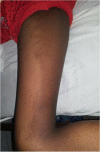Gillespie syndrome in a South Asian child: a case report with confirmation of a heterozygous mutation of the ITPR1 gene and review of the clinical and molecular features
- PMID: 30249237
- PMCID: PMC6154888
- DOI: 10.1186/s12887-018-1286-5
Gillespie syndrome in a South Asian child: a case report with confirmation of a heterozygous mutation of the ITPR1 gene and review of the clinical and molecular features
Abstract
Background: Gillespie syndrome is a rare, congenital, neurological disorder characterized by the association of partial bilateral aniridia, non-progressive cerebellar ataxia and intellectual disability. Homozygous and heterozygous pathogenic variants of the ITPR1 gene encoding an inositol 1, 4, 5- triphosphate- responsive calcium channel have been identified in 13 patients recently. There have been 22 cases reported in the literature by 2016, mostly from the western hemisphere with none reported from Sri Lanka.
Case presentation: A 10-year-old girl born to healthy non-consanguineous parents with delayed development is described. She started walking unaided by 9 years with a significantly unsteady gait and her speech was similarly delayed. Physical examination revealed multiple cerebellar signs. Slit lamp examination of eyes revealed bilateral partial aniridia. Magnetic resonance imaging of brain at the age of 10 years revealed cerebellar (mainly vermian) hypoplasia. Genetic testing confirmed the clinical suspicion and demonstrated a heterozygous pathogenic variant c.7786_7788delAAG p.(Lys2596del) in the ITPR1 gene.
Conclusion: The report of this child with molecular confirmation of Gillespie syndrome highlights the need for careful evaluation of ophthalmological and neurological features in patients that enables correct clinical diagnosis. The availability of genetic testing enables more accurate counseling of the parents and patients regarding recurrence risks to other family members.
Keywords: Cerebellar hypoplasia; Gillespie syndrome; ITPR1 gene; Partial aniridia.
Conflict of interest statement
Ethics approval and consent to participate
Ethics approval was not sought as this patient was investigated as part of routine clinical care.
Written informed consent was obtained from the proband’s parents for genetic testing as part of standard care. A copy of the written consent is available for review by the corresponding author.
Consent for publication
Written informed consent was obtained from the proband’s parents for the publication of all personal information contained in this case report. A copy of the written consent is available for review by the corresponding author.
Competing interests
The authors declare that they have no competing interests.
Publisher’s Note
Springer Nature remains neutral with regard to jurisdictional claims in published maps and institutional affiliations.
Figures



Similar articles
-
Phenotypic Spectrum and Natural History of Gillespie Syndrome. An Updated Literature Review with 2 New Cases.Cerebellum. 2024 Dec;23(6):2655-2670. doi: 10.1007/s12311-024-01733-7. Epub 2024 Aug 23. Cerebellum. 2024. PMID: 39177731 Free PMC article. Review.
-
A novel de novo intronic variant in ITPR1 causes Gillespie syndrome.Am J Med Genet A. 2021 Aug;185(8):2315-2324. doi: 10.1002/ajmg.a.62232. Epub 2021 May 5. Am J Med Genet A. 2021. PMID: 33949769 Free PMC article.
-
Additional features of Gillespie syndrome in two Brazilian siblings with a novel ITPR1 homozygous pathogenic variant.Eur J Med Genet. 2018 Mar;61(3):134-138. doi: 10.1016/j.ejmg.2017.11.005. Epub 2017 Nov 21. Eur J Med Genet. 2018. PMID: 29169895
-
Identification of novel and hotspot mutations in the channel domain of ITPR1 in two patients with Gillespie syndrome.Gene. 2017 Sep 10;628:141-145. doi: 10.1016/j.gene.2017.07.017. Epub 2017 Jul 8. Gene. 2017. PMID: 28698159 Free PMC article.
-
Missense mutation in the ITPR1 gene presenting with ataxic cerebral palsy: Description of an affected family and literature review.Neurol Neurochir Pol. 2017 Nov-Dec;51(6):497-500. doi: 10.1016/j.pjnns.2017.06.012. Epub 2017 Jul 8. Neurol Neurochir Pol. 2017. PMID: 28826917 Review.
Cited by
-
Gillespie's Syndrome Phenotype in A Patient with a Homozygous Variant of Uncertain Significance in the ITPR1 Gene.Neuroophthalmology. 2021 Oct 13;46(3):186-189. doi: 10.1080/01658107.2021.1982991. eCollection 2022. Neuroophthalmology. 2021. PMID: 35574166 Free PMC article.
-
A C1976Y missense mutation in the mouse Ip3r1 gene leads to short-term mydriasis and unfolded protein response in the iris constrictor muscles.Exp Anim. 2020 Jan 29;69(1):45-53. doi: 10.1538/expanim.19-0007. Epub 2019 Aug 8. Exp Anim. 2020. PMID: 31391379 Free PMC article.
-
Phenotypic Spectrum and Natural History of Gillespie Syndrome. An Updated Literature Review with 2 New Cases.Cerebellum. 2024 Dec;23(6):2655-2670. doi: 10.1007/s12311-024-01733-7. Epub 2024 Aug 23. Cerebellum. 2024. PMID: 39177731 Free PMC article. Review.
-
A Rare Case of Mosaic 3pter and 5pter Deletion-Duplication with Autism Spectrum Disorder and Dyskinesia.Case Rep Genet. 2023 Oct 16;2023:7974886. doi: 10.1155/2023/7974886. eCollection 2023. Case Rep Genet. 2023. PMID: 37876589 Free PMC article.
-
Disease-associated mutations in inositol 1,4,5-trisphosphate receptor subunits impair channel function.J Biol Chem. 2020 Dec 25;295(52):18160-18178. doi: 10.1074/jbc.RA120.015683. Epub 2020 Oct 22. J Biol Chem. 2020. PMID: 33093175 Free PMC article.
References
-
- Agarwal PK, Awan MA, Dutton GN, Strang N. Gillespie syndrome with impaired accommodation. J Pediatr Ophthalmol Strabismus. 2009;46(1):60. - PubMed
Publication types
MeSH terms
Substances
Supplementary concepts
Grants and funding
LinkOut - more resources
Full Text Sources
Other Literature Sources

